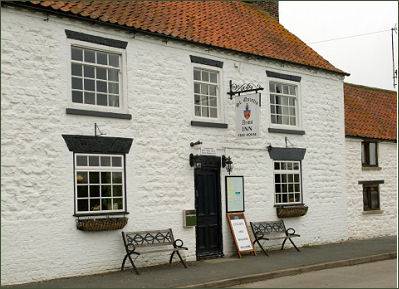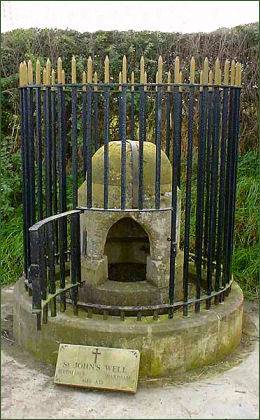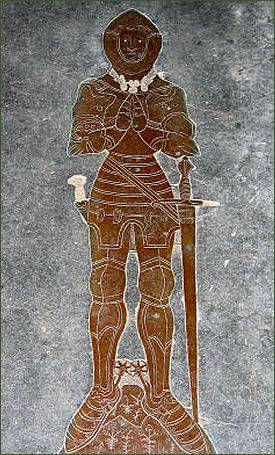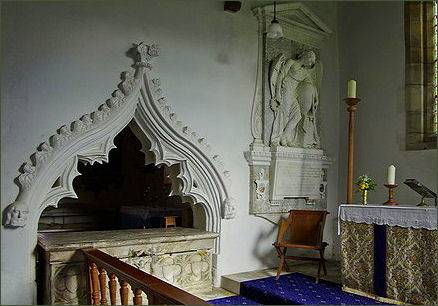Harpham
OS grid reference:- TA 095 615
 The small tranquil village of Harpham is of ancient origin and lies around 7 miles (11 km) to the south-west of the coastal town of Bridlington.
The small tranquil village of Harpham is of ancient origin and lies around 7 miles (11 km) to the south-west of the coastal town of Bridlington.
 St John of Beverley was born in the village in the seventh century and educated at Whitby Monastery. He became the Bishop of Hexham and later the Bishop of York in 705 AD. Shortly before his death he founded a Christian fellowship in Beverley and there is a tomb in Beverley Minster in his memory.
St John of Beverley was born in the village in the seventh century and educated at Whitby Monastery. He became the Bishop of Hexham and later the Bishop of York in 705 AD. Shortly before his death he founded a Christian fellowship in Beverley and there is a tomb in Beverley Minster in his memory.
The village pub, the St. Quintin Arms (pictured left) is an old coaching inn and dates back to the sixteenth century. The pub serves reasonably priced home-made food and offers accommodation.
The village contains two famous wells. St. John's Well (pictured right), which is protected by iron railings, is situated at the western edge of the village at the end of a farm road. Local legend claims that the well sprung from the ground when the St. John of Beverley struck it with his staff. Tradition claims that the water is useful for curing headaches, eye issues and overcoming infertility. The well is situated on the outskirts of the village and is decorated by local school children on the nearest Tuesday to the 7th May each year.(St John of Beverley's day).
The Drummer Boy Well stands in the field by the former St. Quentin manor, it rises from a circular stone well shaft about 4 feet in diameter. The name of the well commemorates the death of a drummer boy. Local legend recalls two versions of how the boy met his end; one of which blames the St Quintin lord of the manor.
According to the first version of the story, King William the Conqueror promised to grant the manor of Harpham to whoever could reach it first. The first to arrive was the drummer boy, close behind him was St Quintin, who, eager to claim the land for himself, threw the poor boy down the well, where he drowned. Since then, so the quaint story goes, the sound of drumming can be heard from the well whenever the head of the St Quintin family is about to die. The second version of the tale relates that the St Quintin lord of Harpham manor , whilst observing an archery tournament in the field, accidentally knocked into a drummer boy, who lost his balance, fell into the well.
Church of St. John of Beverley
 The village church of St. John of Beverley is a Grade I listed building. The church was built by Sir William St Quintin in the fourteenth century. It contains the St Quintin tombs. The chest tomb of William St Quintin is topped by an carved alabaster slab and set beneath a beautifully carved ogee canopy in the wall between the chancel and north chapel. Sir William's memorial is dated 1349 and shows beautifully incised figures of a saint and lady who is thought to be Joan de Thwing.
The village church of St. John of Beverley is a Grade I listed building. The church was built by Sir William St Quintin in the fourteenth century. It contains the St Quintin tombs. The chest tomb of William St Quintin is topped by an carved alabaster slab and set beneath a beautifully carved ogee canopy in the wall between the chancel and north chapel. Sir William's memorial is dated 1349 and shows beautifully incised figures of a saint and lady who is thought to be Joan de Thwing.
 The north chapel contains fifteenth century brasses set into the floor. The first is that of Thomas St Quintin and his wife Agnes (d. 1440). The second brass is another Thomas St Quintin (d. 1444). There is also a stained glass window in memory of Sir William St Quintin, twenty-eighth in succession, who died in 1777.
The north chapel contains fifteenth century brasses set into the floor. The first is that of Thomas St Quintin and his wife Agnes (d. 1440). The second brass is another Thomas St Quintin (d. 1444). There is also a stained glass window in memory of Sir William St Quintin, twenty-eighth in succession, who died in 1777.
The village was the residence of the St Quintin family whose founder, Herbert St Quintin, is reputed to have fought under William the Conqueror and aquired land in East Yorkshire. In the early twelfth century Herbert St Quintin's descendant, Oliver St Quintin, was married to Adeliza who founded the Cistercian priory for nuns near Appleton. Oliver's eldest son Sir Robert was a knight warrior, was one of twelve knights, who along with Robert FitzHamon, conquered lands in Wales during the reign of William Rufus.
The village was the residence of the St Quintin family whose founder, Herbert St Quintin, is reputed to have fought under William the Conqueror and aquired land in East Yorkshire. In the early twelfth century Herbert St Quintin's descendant, Oliver St Quintin, was married to Adeliza who founded the Cistercian priory for nuns near Appleton.
Oliver's eldest son Sir Robert was a knight warrior, was one of twelve knights, who along with Robert FitzHamon, conquered lands in Wales during the reign of William Rufus. The second son, Herbert St Quintin, caqrried on the family line which became feudal barons of Brandesburton and Skipsea in the early thirteenth century. His marriage to Agnes de Stuteville brought Harpham into the family where they resided and were buried until the second half of the seventeenth century. In a field beside the church a few bumps and hollows in a field are all that now remains of a medieval manor built by the St Quintin family.
Towns and Villages of Yorkshire
